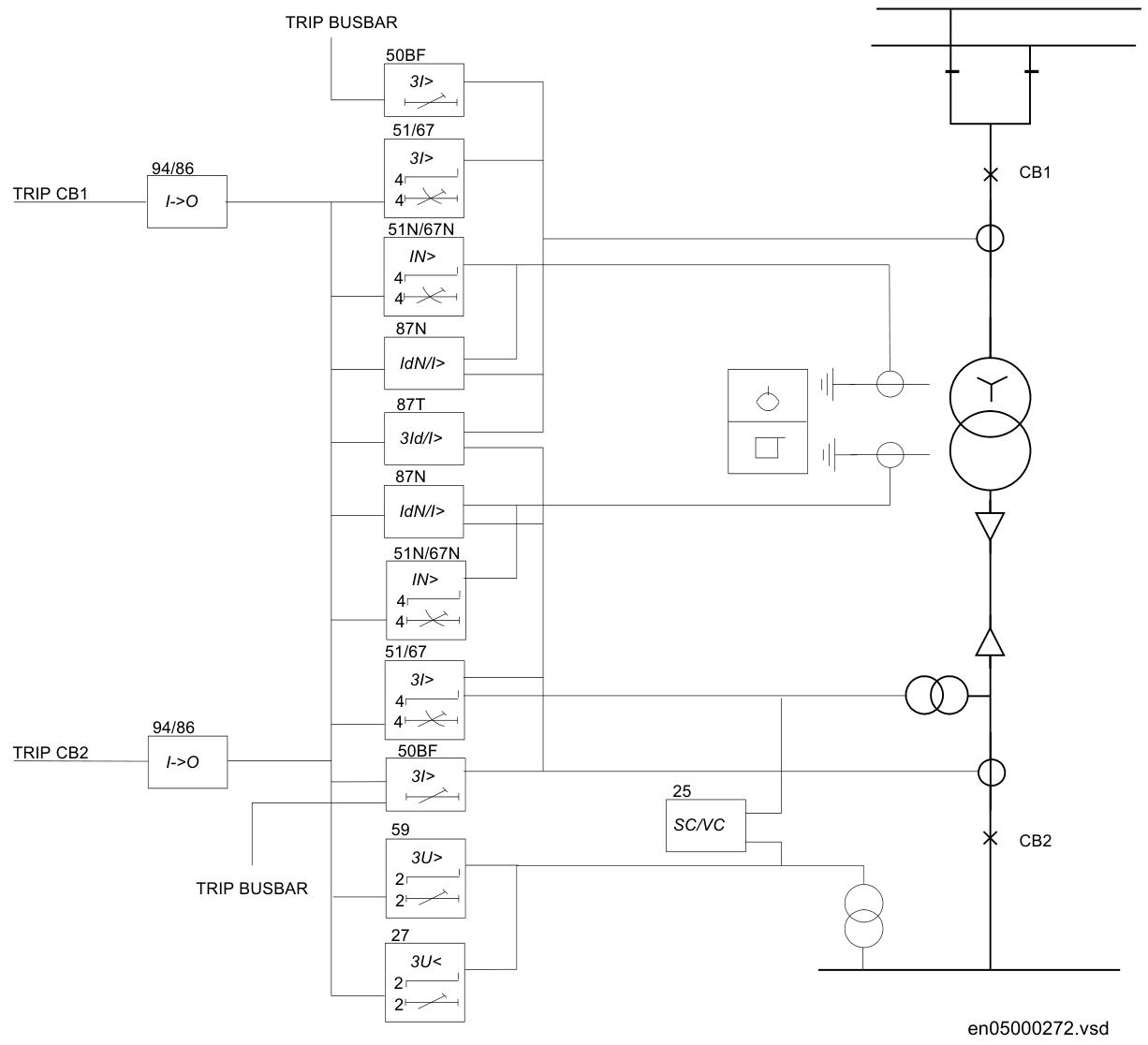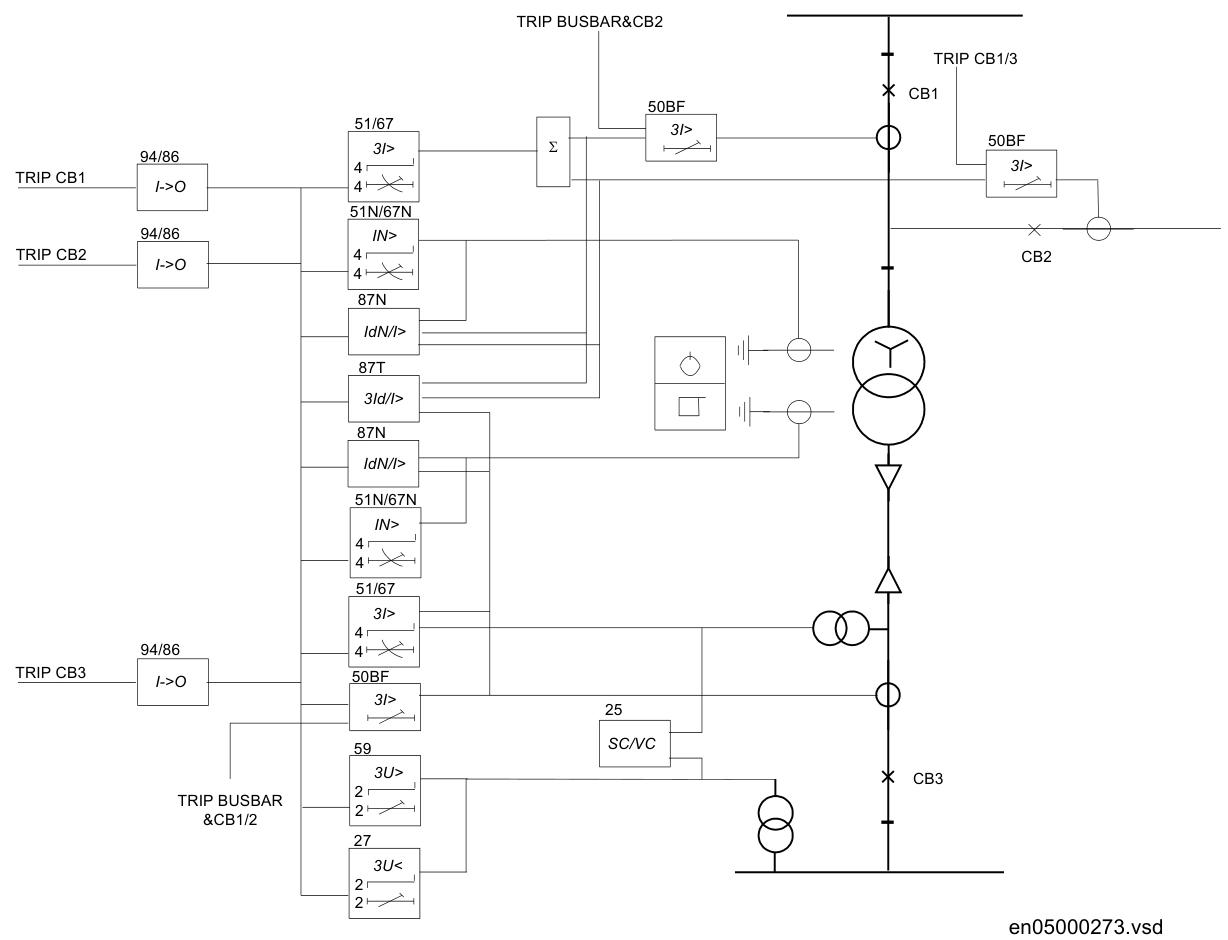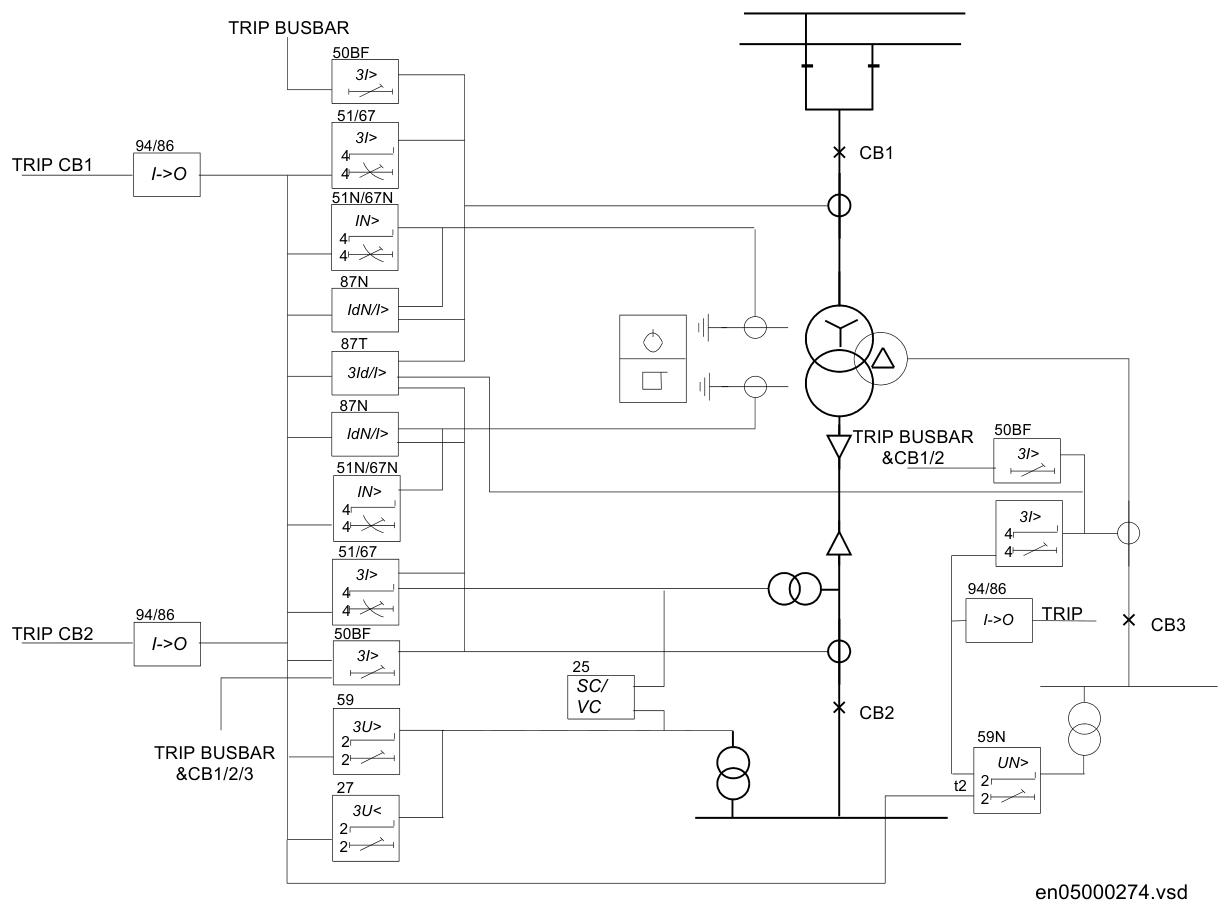

K-WANG


ABB RET670 Transformer Protection Device
ABB RET670 Transformer Protection Device
Product positioning and application
RET670 is ABB Relion ® The transformer protection device in the 670 series is mainly used for fast, selective protection, monitoring, and control of double winding, three winding transformers, autotransformers, generator transformer groups, and parallel reactors. Its design can adapt to a wide frequency range, cope with power grid disturbances and frequency changes during generator start stop, and is suitable for various circuit breaker configurations (single circuit breaker, multiple circuit breakers). It also provides six pre configuration schemes to meet different scenario requirements, such as transformer backup protection, voltage control, and the application of dual winding/triple winding transformers in single circuit breaker or multiple circuit breaker arrangements.

Core protection function
Differential protection
It includes dual winding (T2WPDIF) and triple winding (T3WPDIF) transformer differential protection, with automatic CT ratio matching and vector group compensation functions. It avoids excitation inrush current misoperation through second harmonic and wave blocking braking, and prevents overexcitation misoperation through fifth harmonic braking. It has high sensitivity to winding turn faults.
Low impedance limited ground fault protection (REFPDIF): As a supplementary protection for winding ground faults, it includes a zero sequence current direction criterion, with high sensitivity (as low as 5%) and rapid action.
High impedance differential protection (HZPDIF): can be used to limit ground faults or differential protection of autotransformers, tertiary reactors, etc., requiring external CT current summation, series resistance, and varistor coordination.
Impedance protection
Quadrilateral characteristic distance protection (ZMQPDIS, etc.): used for backup protection of transformer and connected power grid faults, supports multiple fault loops, can independently set directional or non directional modes, and has load intrusion detection function.
Mu Ou characteristic full range distance protection (ZMHPDIS, etc.): four zone protection, suitable for backup protection of lines and cables, supporting single pole automatic reclosing.

Current protection
Instantaneous/four step overcurrent protection: covering phase current, residual current, negative sequence current, etc., supporting direction and voltage control, providing multiple inverse time characteristic curves.
Thermal Overload Protection (TRPTTR): Based on a dual time constant thermal model, it estimates the internal temperature of the equipment and provides two-level warning and trip functions.
Circuit Breaker Failure Protection (CCRBRF): Quickly trip surrounding circuit breakers when the circuit breaker refuses to move, supporting current, contact, or adaptive criteria.
Other Protection
Voltage protection: including overvoltage (OV2PTOV), undervoltage (UV2PTUV), residual overvoltage (ROV2PTOV), etc., can be set with inverse time limit or definite time limit characteristics.
Frequency protection: including under frequency (SAPTUF), over frequency (SAPTOF), and frequency change rate (SAPFRC) protection, used for load shedding, power generation control, etc.
Overexcitation protection (OEXPVPH): prevents transformer/generator from overheating and damage due to high magnetic density, supports custom inverse time curve.
Control and monitoring functions
control function
Synchronization Check and Synchronization (SESRSYN): Check the voltage synchronization on both sides of the circuit breaker, support manual and automatic reclosing, and adapt to dual busbar, ring busbar and other arrangements.
Equipment Control (APC): Used for controlling and monitoring circuit breakers, isolating switches, etc., supporting the "select execute" principle and providing command models for different safety levels.
Tap control (TR1ATCC, etc.): Automatically adjust the transformer tap to stabilize the secondary voltage, supporting control of single or multiple parallel transformers.
Monitoring and Recording
Measurement function: Real time monitoring of parameters such as voltage, current, power, frequency, etc., calculating positive sequence, negative sequence, and zero sequence components.
Event and disturbance recording: Built in disturbance recorder (DRPRDRE), records analog and switch data before and after faults, supports Comtrade format for easy fault analysis.
Counter and Measurement: The Pulse Counter (PCGGIO) records external pulses, while the Energy Calculation Function (ETPMMTR) calculates active/reactive energy and maximum demand.
Communication and Interface
Communication functions and protocols
RET670 has rich communication capabilities, supports multiple industry standard protocols, and can flexibly access automation systems at different levels, including:
Station level communication protocol
IEC 61850-8-1: Implemented through a single or dual channel fiber optic Ethernet interface (OEM module), supports GOOSE peer-to-peer communication, facilitates data exchange between intelligent electronic devices (IEDs) from different manufacturers, can upload perturbation files, and has a communication rate of 100BASE-FX.
LON protocol: Connected through an optical LON interface, supporting the expansion of existing ABB station level LON networks, achieving peer-to-peer communication and collaborative work with other ABB IEDs, with a communication rate of 1.25 Mbit/s.
SPA/IEC 60870-5-103 protocol: Implemented through serial and LON communication modules (SLM), SPA protocol is suitable for simple substation automation systems, IEC 60870-5-103 supports multi vendor device integration, and communication rates can be configured (such as 9600, 19200 Bd, etc.).
DNP3.0 protocol: implemented through electrical RS485 or fiber optic Ethernet interface, supporting TCP/IP and EIA-485 communication, with event transmission, time synchronization, and disturbance reporting functions, suitable for communication with RTU, gateway, or HMI systems.
Redundant communication: Supports IEC 62439-3 parallel redundancy protocol (Edition 1 and Edition 2), achieves redundant station level communication through dual ports, and improves communication reliability.
Remote communication: It can exchange analog and switch signals with remote IEDs through Line Data Communication Module (LDCM), supports IEEE/ANSI C37.94 standard, suitable for short distance (<60 km) and medium distance (extended to<3 km through optical to electrical converters) communication, supports multiple fiber types (multimode, single-mode) and wavelengths (850 nm, 1310 nm).

- YOKOGAWA
- Energy Access
- Renewable Integration
- Energy Subsidies
- Energy and Water
- Net zero emission
- Energy Security
- Critical Minerals
- A-B
- petroleum
- Mine scale
- Energy and Gender
- Covid-19
- man-machine
- Reliance
- ADVANCED
- SEW
- ProSoft
- WATLOW
- Kongsberg
- FANUC
- VSD
- DCS
- PLC
- Sewage treatment
- cement
- Yaskawa
- Woodward
- BOSCH Rexroth
- MOOG
- General Electric
- American NI
- Rolls-Royce
- CTI
- Honeywell
- EMERSON
- xYCOM
- Construction site
- Siemens
- architecture
- Industrial information
- New energy
- Automobile market
- electricity
- Motorola
- HIMA
- ABB
- Rockwell
- Schneider Modicon
- MAN
- GE
- TRICONEX
- Control Wave
- ALSTOM
- AMAT
- STUDER
- KONGSBERG
- MOTOROLA
- DANAHER MOTION
- Bentley
- Galil
- EATON
- MOLEX
- Triconex
- DEIF
- B&W
- ZYGO
- Aerotech
- DANFOSS
- KOLLMORGEN
- Beijer
- Endress+Hauser
- schneider
- Foxboro
- KB
- REXROTH
-
Kollmorgen S33GNNA-RNNM-00 - Brushless Servo Motor
-
Kollmorgen 6sm56-s3000-g-s3-1325 - Servo Motor
-
Kollmorgen AKM52K-CCCN2-00 - Servo Motor
-
Kollmorgen PSR3-230/75-21-202 - Power Supply
-
Kollmorgen akm24d-anc2r-00 - Servo Motor
-
Kollmorgen AKM22E-ANCNR-00 - Servo Motor
-
Kollmorgen S60300-550 - Servo Drive
-
Kollmorgen B-204-B-21 - Servomotor
-
Kollmorgen AKM21E-BNBN1-00 - Servo Motor
-
Kollmorgen TT2953-1010-B - DC Servo Motor
-
Kollmorgen pa8500 - Servo Power Supply
-
Kollmorgen BDS4A-210J-0001-207C2 - Servo Drive
-
Kollmorgen TTRB1-4234-3064-AA - DC Servo Motor
-
Kollmorgen MH-827-A-43 - Servo Motor
-
Kollmorgen AKM24D-ACBNR-OO - Servo Motor
-
Kollmorgen 00-01207-002 - Servo Disk DC Motor
-
Kollmorgen AKM21C-ANBNAB-00 - Servo Motor
-
Kollmorgen PSR3-208/50-01-003 - Power Supply
-
Kollmorgen 6SM56-S3000 - Servo Motor
-
Kollmorgen DBL3H00130-B3M-000-S40 - Servo Motor
-
Kollmorgen 6SN37L-4000 - Servo Motor
-
Kollmorgen AKM65K-ACCNR-00 - Servo motor
-
Kollmorgen 6SM56-L3000-G - Servo Motor
-
Kollmorgen AKMH43H-CCCNRE5K - Servo Motor
-
Kollmorgen PSR4/52858300 - Power Supply
-
Kollmorgen KBM-79H03-E03 - Direct Drive Rotary Motor
-
Kollmorgen AKM33E-ANCNDA00 - Servo Motor
-
Kollmorgen U9M4/9FA4T/M23 - ServoDisc DC Motor
-
Kollmorgen AKM13C-ANCNR-00 - Servo Motor
-
Kollmorgen AKM43L-ACD2CA00 - Servo Motor
-
Kollmorgen AKM54K-CCCN2-00 - Servo Motor
-
Kollmorgen M-605-B-B1-B3 - Servo Motor
-
Kollmorgen AKD-P00606-NBAN-0000 - Rotary Drive
-
Kollmorgen 6SM-37M-6.000 - Servo Motor
-
Kollmorgen A.F.031.5 - Sercos Interface Board
-
Kollmorgen 918974 5054 - Servo PWM
-
Kollmorgen U12M4 - ServoDisc DC Motor
-
Kollmorgen AKD-B00606-NBAN-0000 - Servo Drive
-
Kollmorgen MV65WKS-CE310/22PB - Servo Drive
-
Kollmorgen 65WKS-CE310/22PB - Servo Drive
-
Kollmorgen EM10-27 - Module
-
Kollmorgen S64001 - Servo Drive
-
Kollmorgen CR03200-000000 - Servo Drive
-
Kollmorgen 6SM57M-3000+G - Servo Motor
-
Kollmorgen BDS4 - Servo Drive
-
Kollmorgen AKD-P00306-NBEC-000 - Servo Drive
-
Kollmorgen AKD-B01206-NBAN-0000 - Servo Drive
-
Kollmorgen STP-57D301 - Stepper Motor
-
Kollmorgen 6SM37L-4.000 - Servo Motor
-
Kollmorgen 44-10193-001 - Circuit Board
-
Kollmorgen PRDR9SP24SHA-12 - Board
-
Kollmorgen PRD-AMPE25EA-00 - Servo Drive
-
Kollmorgen DBL3N00130-0R2-000-S40 - Servo Motor
-
Kollmorgen S406BA-SE - Servo Drive
-
Kollmorgen AKD-P00607-NBEI-0000 - Servo Drive
-
Kollmorgen AKD-P01207-NBEC-0000 - Servo Drive
-
Kollmorgen CR03550 - Servo Drive
-
Kollmorgen VSA24-0012/1804J-20-042E - Servo Drive
-
Kollmorgen N2-AKM23D-B2C-10L-5B-4-MF1-FT1E-C0 - Actuator
-
Kollmorgen 04S-M60/12-PB - Servo Drive
-
Kollmorgen H33NLHP-LNW-NS50 - Stepper Motor
-
Kollmorgen A-78771 - Interlock Board
-
Kollmorgen AKM43E-SSSSS-06 - Servo Motor
-
Kollmorgen AKD-P00607-NBEC-0000 - Servo Drive
-
Kollmorgen E21NCHT-LNN-NS-00 - Stepper Motor
-
Kollmorgen cr10704 - Servo Drive
-
Kollmorgen d101a-93-1215-001 - Motor
-
Kollmorgen BDS4A-203J-0001-EB202B21P - Servo Drive
-
Kollmorgen MCSS23-6432-002 - Connector
-
Kollmorgen AKD-P01207-NACC-D065 - Servo Drive
-
Kollmorgen CK-S200-IP-AC-TB - I/O Adapter and Connector
-
Kollmorgen CR10260 - Servo Drive
-
Kollmorgen EC3-AKM42G-C2R-70-04A-200-MP2-FC2-C0 - Actuator
-
Kollmorgen BDS5A-206-01010-205B2-030 - Servo Drive
-
Kollmorgen s2350-vts - Servo Drive
-
Kollmorgen AKM24D-ANC2DB-00 - Servo Motor
-
Kollmorgen E31NCHT-LNN-NS-01 - Stepper Motor
-
Kollmorgen PRD-0051AMPF-Y0 - Servo Board
-
Kollmorgen TB03500 - Module
-
Kollmorgen 60WKS-M240/06-PB - Servo Drive
-
Kollmorgen M21NRXC-LNN-NS-00 - Stepper Motor
-
Kollmorgen H-344H-0212 - Servo Motor
-
Kollmorgen MCSS08-3232-001 - Connector
-
Kollmorgen AKM33H-ANCNC-00 - Servo Motor
-
Kollmorgen PA-2800 - Power Supply
-
Kollmorgen MTC308C1-R1C1 - Servo Motor
-
Kollmorgen PRDR0091300Z-00 - Capacitor Board
-
Kollmorgen BDS4A-206J-0024/01502D79 - Servo Drive
-
Kollmorgen S20330-VTS - Servo Drive
-
Kollmorgen S20250-CNS - Servo Drive
-
Kollmorgen SBD2-20-1105-WO - Servo Drive Board
-
Kollmorgen M405-C-A1--E1 - Servo Motor
-
Kollmorgen PRD-PB805EDD-00 - Servo Drive
-
Kollmorgen 6SM57S-3.000-J-09-HA-IN - Servo Motor
-
Kollmorgen AKM33H-ANCNDA-00 - Servo Motor
-
Kollmorgen PCB-00030200-04 - PCB
-
Kollmorgen H22SSLB-LNN-NS-02 - Stepper Motor
-
Kollmorgen BJRL-20012-110001 - Module
-
Kollmorgen BDS4A-206J-0001404A - Servo Drive
-
Kollmorgen H-342-H-0802 - Servo Motor
-
Kollmorgen CR10561 - Servo Drive
-
Kollmorgen BDS5A-206-00010-205B2-030 - Servo Drive
-
Kollmorgen BDS5A-206-00010-207B-2-030 - Servo Drive
-
Kollmorgen mcss08-3224-001 - Connector
-
Kollmorgen M-207-B-23-B3 - Servo Motor
-
Kollmorgen PRD-0041200Z-S0 - Encoder/Resolver Card
-
Kollmorgen MH-225-G-61 - Motor
-
Kollmorgen MT308B1-T1C1 - Servo Motor
-
Kollmorgen BDS4A-240J-0001604C83 - Servo Drive
-
Kollmorgen 6SM57-S-3000 - Servo Motor
-
Kollmorgen N-T31V-15-5B-6-MF3-FT1E-C251 - Actuator
-
Kollmorgen PRD-0051AMPA-X0 - Servo Board
-
Kollmorgen CF-SS-RHGE-09 - Cable
-
Kollmorgen DIGIFAS7204 - Servo Drive
-
Kollmorgen S30101-NA - Servo Drive
-
Kollmorgen DIGIFAS7201 - Servo Drive
-
Kollmorgen PRD-0051AMPA-Y0 - Servo Board
-
Kollmorgen AKM23D-EFCNC-00 - Servo Motor
-
Kollmorgen SE10000 - Servo Drive
-
Kollmorgen PSR4/5A-112-0400 - Power Supply
-
Kollmorgen AKM31H-ANCNC-01 - Servo Motor
-
Kollmorgen M-203-B-93-027 - Servo Motor
-
Kollmorgen CP-SS-G1HE-05 - Connector
-
Kollmorgen AKM42G-ASCNR-02 - Servo Motor
-
Kollmorgen DBL4N00750-B3M-000-S40 - Servo Motor
-
Kollmorgen R3-BK23-152B-12-PL-ASE-BS115 - Actuator
-
Kollmorgen MH-427-B-61 - Motor
-
Kollmorgen cr06902 - Servo Drive




